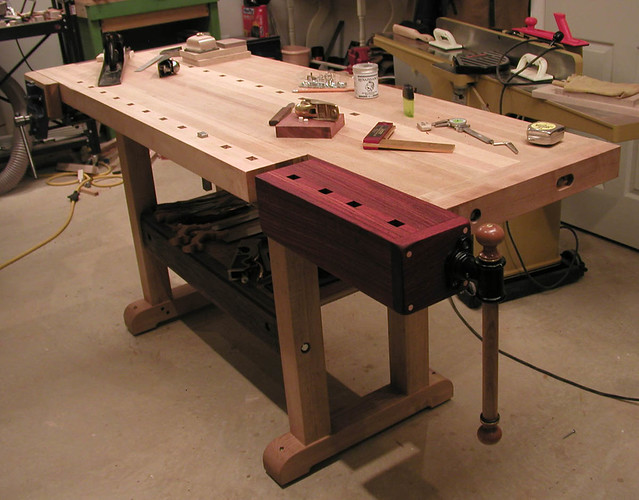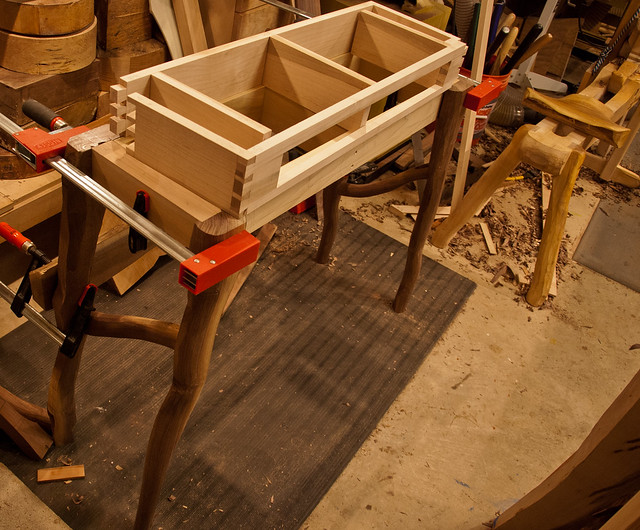For nearly 2 decades I worked without a tail vise. Now I have one (the BC wagon vise) and I know I did it the hard way in the past. The tail vise has opened up so many extra avenues to hold work.
Regards from Perth
Derek
I've been considering what kind of end vice I want when I start my workbench rebuild. I don't have any end vice today, but I would like one, and plan to add one when I make a new top for the workbench (I also plan to add a leg vice instead of my current front vice).
I initially thought about adding a wagon wise. But I recently watched a Tage Frid video, that made me change my mind. I now plan to add a tail vice instead.
I realized that with a tail vice, I don't only get the dog holes, but also the possibility to clamp things between the jaws.
I'm attaching a few screen shots from the video, where Tage Frid is sawing half blind dovetails using the tail vice. This is what changed my mind. Being able to clamp things at an angle, like this, would be very useful. I can see how this would be a good alternative to a Moxon "vice on bench".
shot0001.jpg
shot0008.jpg
shot0009.jpg
This is of interest to me too. Great to have the quality options we do now.
When I was considering options, I was under the impression that wagons are appropriate when a tail vise is hard to install. Is there another reason a wagon is better than a traditional tail?
I just installed the Veritas QR tail vise on my new bench and I really like it.
There are a few different types of vises for the tail end of a bench.
What kind of vise is it that you are considering changing to a leg vise?
Could it be used as your tail vise?
Someone posted pictures the other day with a wedge driven wagon vise. It has me thinking I can have a wagon vise and a tail vise without them interfering with each other.
jtk
"A pessimist sees the difficulty in every opportunity; an optimist sees the opportunity in every difficulty."
- Sir Winston Churchill (1874-1965)
A real tail vise allows holding boards vertically (and very securely at that) without any bars inthe way as opposed to a wagon vise that only holds stuff laying on your bench. A tail vice is much more versatile. Mine:

Hi Sean
That is a beautiful vice (and bench). I would have liked one, however it would not have suited my shop, as the space I have for a bench is limited. The advantage of the wagon vise is that it takes up less room behind the bench. That allowed me to extend my bench top by 6-8".
Incidentally, you certainly can clamp boards vertically in a BC wagon vise - as long as they go into the slot length-ways - as the screw is offset.
Regards from Perth
Derek
Do you really use it that way, Derek? I would think that holding something like an 8 inch wide drawer side by it's edges wouldn't really be secure for ripping dovetails, for example? Plus, how wide is that slot? Could it hold an 8/4 plank? I don't have a wagon vise, and don't mean to denigrate them in any event, but just had never heard of or imagined that they would be optimal for holding boards in the way you describe. Learn something new everyday in ww'ing!
I was inspired to build a tail vise by the writings of James Krenov. I've worked with it for so long that I just can't bring myself to change styles. After 15 years I took it apart and replaced the worn runners. The construction of a traditional tail vise is a pretty rich puzzle. Really, a puzzle. And they need the occasional couple hours to re-true. Keeping the faces parallel and mar-free is a bit of a challenge, but having built the vise in the first place it is mine to understand and to keep up. When the faces are, indeed, parallel they grip quite well.
I don't think all this maintenance and bother is for everybody. I also think a state-of-the-art metallic sub structure as sold by LN or LV probably circumvents most of the problems with an all-wood vise. We are truly blessed with these thoughtful and high-integretity alternatives.
The wagon vise is, obviously, far easier to build. But in making musical instruments I use my tail vise a good deal to hold small parts. For example, in roughing out and then finishing a guitar bridge of rosewood I pretty much use the vise from start to finish. There just isn't much of an alternative short of a huge metal vise fitted with high-quality wooden jaws. This is actually an outstanding "second operation" vise if one can avoid using it for metal work, thus contaminating the operating theater with metal chips that can get into the wood work.
This is such a hard discussion. A bench is just such an investment, it's not very practical to try out one style then discard it for a second ( speculative ) style. I'm finding myself completely satisfied with my traditional vise.
Good luck in your search.
Last edited by Russell Sansom; 05-16-2013 at 2:39 PM.
Do I really use it that way for dovetails, Sean? No, of course not. The work piece would be to high above the bench and sawing into it would be an exercise in vibration. That is why Moxon invented the dovetail vise. However, should I wish to clamp a board low that was about 2 1/2" - 3" deep and 12" wide, well I could. In the same breath, I do not see myself using a traditional end vise, such as yours, for sawing dovetails. It is simply too low for comfort (assuming your bench is at a similar height to mine, which is 32"). Tenons? I saw them at my leg vise, but I could indeed saw them in the wagon vise. Most of my stretchers are under 2 1/2" -3" wide.
Additional note: I just looked up the specs of the Benchcrafted tailvise: "The vise, when installed for its maximum capacity and using a 5" long dog block, is capable of handling an 11-3/4" wide board".
Here is the offset I mentioned earlier ...
Regards from Perth
Derek
I routinely saw dovetails in my tail vise. Here's a video:
http://www.flickr.com/photos/chevy_c...57607001006126
and here's a pic of my latest project in progress - all the dts you see in this drawer box were sawn in my tail vise with no discomfort fwiw:
Cheers!

You make cool stuff Sean. Where are you putting all these interesting (and I mean interesting in a good way) tables you are making?
BTW...I hate all of you....all you've all done is make it harder to decide what type of tail vise to replace my broken one with...
Woodworking is terrific for keeping in shape, but it's also a deadly serious killing system...
Thank you, Chris. I definitely try to make cool stuff - don't we all?
This will be a vanity - like for a woman to sit at to do her hair and makeup. Its top will be around four feet long and 16" deep. It's designed to be pushed against a wall, and will have a large (22 x 36 range) mirror mounted in the middle of the top. The piece is designed to fit a specific space in a family member's home.